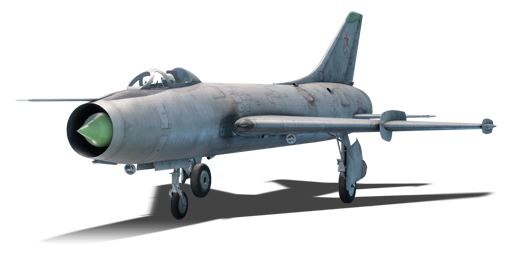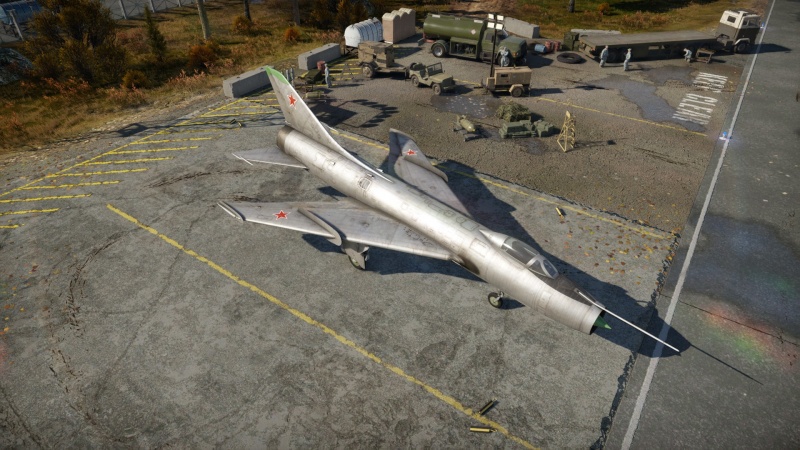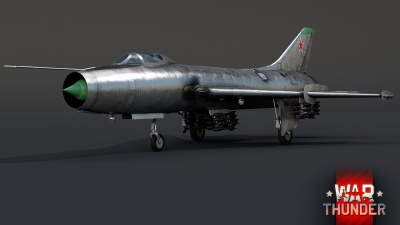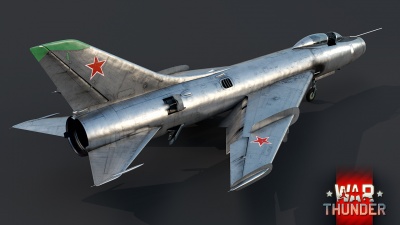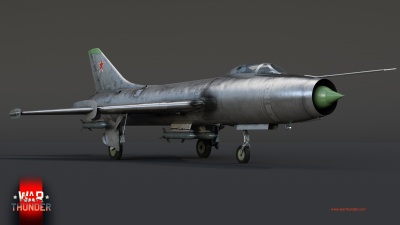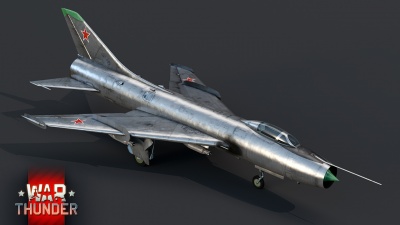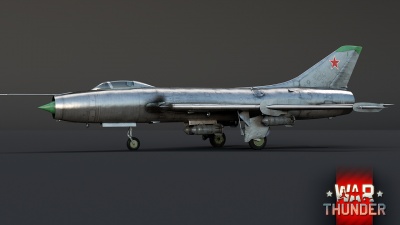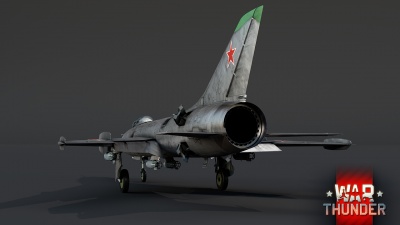Difference between revisions of "Su-7B"
CobraKingII (talk | contribs) (→Media) (Tag: Visual edit) |
CobraKingII (talk | contribs) (→History) (Tag: Visual edit) |
||
| Line 169: | Line 169: | ||
Later, on 31 July 1958, the Soviet Tactical Aviation tasked Sukhoi with developing a ground-attack variant of the Su-7, which could replace the scrapped Ilyushin [[IL-10 (Family)|IL-10]]. The resulting prototype, '''S-22''', incorporated structural refinements for high-speed, low-altitude operations. It first flew in March 1959 and entered service in 1961 as the '''Su-7B'''. | Later, on 31 July 1958, the Soviet Tactical Aviation tasked Sukhoi with developing a ground-attack variant of the Su-7, which could replace the scrapped Ilyushin [[IL-10 (Family)|IL-10]]. The resulting prototype, '''S-22''', incorporated structural refinements for high-speed, low-altitude operations. It first flew in March 1959 and entered service in 1961 as the '''Su-7B'''. | ||
| + | |||
| + | === [[wt:en/news/6738-development-su-7b-new-doctrine-en|Devblog]] === | ||
| + | With the development of jet aviation, piston-engined attack aircraft quickly became an anachronism; a need arose for a new class of front-line aircraft - a fighter bomber. In the USSR, the MiG-15 and MiG-17 fighter jets were used to replace the piston-engined IL-10 to support the ground forces from the air, but it was quite obvious that a specialized machine was needed to fulfill the tasks of the fighter-bomber. The most suitable candidate was the Sukhoi Su-7 fighter jet, taken as the basis for the Su-7B fighter-bomber project. By the end of 1958, the first prototype was ready with the new AL-7F-1 engine. For almost two years, the aircraft underwent intensive testing and refinement, and in 1960 the new fighter-bomber went into mass production. Of the 431 planned, 344 Su-7Bs were built to equip up to 25 combat units. From the beginning of the 70’s, the Su-7B aircraft began to be replaced with more modern modifications and models. | ||
== Media == | == Media == | ||
Revision as of 17:40, 24 January 2021
Contents
Description
The Su-7B is a rank VI Soviet jet fighter with a battle rating of 9.3 (AB/RB) and 9.7 (SB). It was introduced in Update "Starfighters".
General info
Flight performance
Describe how the aircraft behaves in the air. Speed, manoeuvrability, acceleration and allowable loads - these are the most important characteristics of the vehicle.
| Characteristics | Max Speed (km/h at 11,000 m) |
Max altitude (metres) |
Turn time (seconds) |
Rate of climb (metres/second) |
Take-off run (metres) | |||
|---|---|---|---|---|---|---|---|---|
| AB | RB | AB | RB | AB | RB | |||
| Stock | 2,161 | 2,145 | 19000 | 27.4 | 28.2 | 166.4 | 157.6 | 1,250 |
| Upgraded | 2,323 | 2,232 | 26.6 | 27.0 | 227.0 | 195.0 | ||
Details
| Features | |||||
|---|---|---|---|---|---|
| Combat flaps | Take-off flaps | Landing flaps | Air brakes | Arrestor gear | Drogue chute |
| X | X | ✓ | ✓ | X | ✓ |
| Limits | ||||||
|---|---|---|---|---|---|---|
| Wings (km/h) | Gear (km/h) | Flaps (km/h) | Max Static G | |||
| Combat | Take-off | Landing | + | - | ||
| 0 | 630 | N/A | N/A | 473 | ~11 | ~3 |
| Optimal velocities (km/h) | |||
|---|---|---|---|
| Ailerons | Rudder | Elevators | Radiator |
| < 700 | < 650 | < 600 | N/A |
Engine performance
| Engine | Aircraft mass | |||||
|---|---|---|---|---|---|---|
| Engine name | Number | Basic Mass | Wing loading (full fuel) | |||
| Saturn AL-7F-1-100 | 1 | 7,926 kg | 315 kg/m2 | |||
| Engine characteristics | Mass with fuel (no weapons load) | Max Takeoff Weight | ||||
| Weight (each) | Type | 8m fuel | 20m fuel | 27m fuel | ||
| 2,200 kg | Afterburning axial-flow turbojet | 8,756 kg | 10,000 kg | 10,726 kg | 13,043 kg | |
| Maximum engine thrust @ 0 m (RB / SB) | Thrust to weight ratio @ 0 m (WEP) | |||||
| Condition | 100% | WEP | 8m fuel | 20m fuel | 27m fuel | MTOW |
| Stationary | 5,848 kgf | 8,257 kgf | 0.94 | 0.83 | 0.77 | 0.63 |
| Optimal | 6,664 kgf (1,000 km/h) |
9,974 kgf (1,000 km/h) |
1.14 | 1.00 | 0.93 | 0.76 |
Survivability and armour
- 20 mm Aluminium Alloy - pilot's headrest
- 36 mm Aluminium Alloy - pilot's backrest
- 8 mm steel - cockpit front bulkhead
- 102 mm Bulletproof glass - Armoured windscreen
Modifications and economy
Armaments
Offensive armament
The Su-7B is armed with:
- 2 x 30 mm NR-30 cannons, wing-mounted (80 rpg = 160 total)
Suspended armament
The Su-7B can be outfitted with the following ordnance:
- Without load
- 64 x S-5K rockets
- 4 x S-24 rockets
- 28 x S-3K rockets
- 4 x 250 kg OFAB-250sv bombs (1,000 kg total)
- 4 x 500 kg FAB-500M-54 bombs (2,000 kg total)
Usage in battles
Describe the tactics of playing in the aircraft, the features of using aircraft in a team and advice on tactics. Refrain from creating a "guide" - do not impose a single point of view, but instead, give the reader food for thought. Examine the most dangerous enemies and give recommendations on fighting them. If necessary, note the specifics of the game in different modes (AB, RB, SB).
Pros and cons
Pros:
- One of the fastest planes at its battle rating
- Very fast acceleration
- With S-24 rockets you can win every head-on
- Able to zoom climb up to 8,000 m
- 2 x 30 mm cannons are very powerful with Armored targets belt
- Decent energy retention
Cons:
- Huge plane and very fragile
- Underwhelming manoeuvrability
- Very unstable
- Below average roll rate
History
On May 14th 1953, shortly after Stalin's death and the reopening of the Sukhoi OKB, they began work on a swept-wing front-line fighter. Their first prototype was named S-1 and was fitted with the all-new Lyulka AL-7 turbojet. It was the first Soviet aircraft to utilize the all-moving tailplane and a translating centerbody, plus a dramatic wing sweep of 60°, irreversible hydraulically boosted controls, and an ejection seat of Sukhoi's own design. After the success of the S-1, production began with the S-2. later renamed the Su-7.
Later, on 31 July 1958, the Soviet Tactical Aviation tasked Sukhoi with developing a ground-attack variant of the Su-7, which could replace the scrapped Ilyushin IL-10. The resulting prototype, S-22, incorporated structural refinements for high-speed, low-altitude operations. It first flew in March 1959 and entered service in 1961 as the Su-7B.
Devblog
With the development of jet aviation, piston-engined attack aircraft quickly became an anachronism; a need arose for a new class of front-line aircraft - a fighter bomber. In the USSR, the MiG-15 and MiG-17 fighter jets were used to replace the piston-engined IL-10 to support the ground forces from the air, but it was quite obvious that a specialized machine was needed to fulfill the tasks of the fighter-bomber. The most suitable candidate was the Sukhoi Su-7 fighter jet, taken as the basis for the Su-7B fighter-bomber project. By the end of 1958, the first prototype was ready with the new AL-7F-1 engine. For almost two years, the aircraft underwent intensive testing and refinement, and in 1960 the new fighter-bomber went into mass production. Of the 431 planned, 344 Su-7Bs were built to equip up to 25 combat units. From the beginning of the 70’s, the Su-7B aircraft began to be replaced with more modern modifications and models.
Media
See also
Links to the articles on the War Thunder Wiki that you think will be useful for the reader, for example:
- reference to the series of the aircraft;
- links to approximate analogues of other nations and research trees.
External links
| Sukhoi Design Bureau (Сухого Опытное конструкторское бюро) | |
|---|---|
| Jet fighters | Su-9 · Su-11 |
| Su-27 | Su-27 · Su-27SM |
| Strike aircraft | |
| Su-2 | BB-1 · Su-2 (M-82) · Su-2 MV-5 · Su-2 TSS-1 |
| Su-6 | Su-6 · Su-6 (AM-42) · Su-6 (M-71F) |
| Su-7 | Su-7B · Su-7BKL · Su-7BMK |
| Su-8 | Su-8 |
| Su-17 | Su-17M2 · Su-17M4 · Su-22M3 |
| Su-24 | Su-24M |
| Su-25 | Su-25 · Su-25BM · Su-25K · Su-25T · Su-25SM3 · Su-39 |
| Su-34 | Su-34 |
| Export | ◊Su-22UM3K · ◔Su-22M3 · ◊Su-22M4 · ◄Su-22M4 WTD61 |
| J-11* | |
| *CKD and SKD kits assembled by Shenyang Aircraft Corporation | |
| USSR jet aircraft | |
|---|---|
| Bereznyak-Isayev | BI |
| Yakovlev | Yak-15 · Yak-15P · Yak-17 · Yak-23 · Yak-28B · Yak-30D · Yak-38 · Yak-38M · Yak-141 |
| Mikoyan-Gurevich | MiG-9 · MiG-9 (l) · MiG-15 · MiG-15bis · MiG-15bis ISh · MiG-17 · MiG-17AS · MiG-19PT |
| MiG-21F-13 · MiG-21PFM · MiG-21S (R-13-300) · MiG-21SMT · MiG-21bis | |
| MiG-23M · MiG-23ML · MiG-23MLD · MiG-27M · MiG-27K | |
| MiG-29 · MiG-29SMT | |
| Lavochkin | La-174 · La-15 · La-200 |
| Sukhoi | Su-9 · Su-11 |
| Su-7B · Su-7BKL · Su-7BMK · Su-17M2 · Su-17M4 · Su-22M3 | |
| Su-24M | |
| Su-25 · Su-25BM · Su-25K · Su-25T · Su-25SM3 · Su-39 | |
| Su-27 · Su-27SM | |
| Su-34 | |
| Ilyushin | IL-28 · IL-28Sh |
| Tupolev | Tu-14T |


